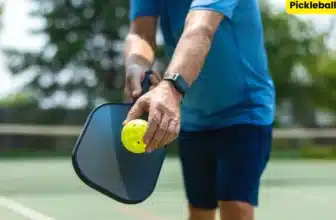
With pickleball gaining popularity in recent years, it is quite evident why people love this sport so much. Playing pickleball is an enjoyable experience, particularly because it’s easy to learn the basics and start playing quickly. This is due to the game’s straightforward rules and familiar mechanics.
However, there is one aspect of the game that can be challenging, and that is anything related to the kitchen. If the word “kitchen” has confused you, hang on, because there’s more. It’s the “pickleball kitchen rules” that confuses almost every player who has just started playing this game since 1965, the year this game was invented.
What is Kitchen in Pickleball?
Also known as the “non-volley” zone of the pickleball court, the kitchen in Pickleball is the seven-foot zone in each side of the net. The reason why it’s called the non volley zone is that a player is not allowed to volley while standing in this area.

Here are a few important points for this zone of the court:
- Intense and exciting pickleball rallies happen in and around this court area.
- Many scoring opportunities arise at the kitchen line.
- Playing at the kitchen line requires quick reactions for impactful shots.
Why is it Called the Kitchen in Pickleball?
Many people don’t know what exactly is the reason behind the kitchen being called so. But there are a few popular theories that many people think are true:
Shuffleboard Connection:
Pickleball’s use of the term “kitchen” might be influenced by shuffleboard, where the kitchen is a setback area costing players points. Landing in the shuffleboard kitchen means losing 10 points—a situation no player desires.
Creative Inspiration:
As pickleball’s originators drew inspiration from various leisure games, borrowing the term from shuffleboard seems plausible.
Heat and Pressure:
Positioned only 14 feet apart at the kitchen line, both teams experience intense rallies. The phrase “if you can’t stand the heat, get out of the kitchen” gains significance here, especially when players step into the kitchen to make a shot. A blend of shuffleboard influence and the heat metaphor likely contributes to the term’s adoption in pickleball.
Size of a Kitchen Pickleball
Before diving straight into the pickleball kitchen rules, let’s first understand the kitchen in a bit more detail. Here are a few important figures you may want to know about the kitchen in a pickleball court:
- Standard pickleball court size: 44 feet long by 20 feet wide.
- Kitchen area: Extends 7 feet from the net on both sides, covering the full width.
- On each side of the net, the kitchen is 7 feet deep by 20 feet wide.
- Total kitchen area: 140 square feet.

Pickleball Kitchen Rules to Know
Being someone who loves playing pickleball, it is important for you to learn the kitchen rules pickleball early. Here are the pickleball kitchen rules you must know:
- Kitchen Boundaries:
Avoid volleying inside the kitchen. Even if your toe touches the line, hitting the ball is considered a fault.
- Momentum Matters:
Steer clear of the kitchen during your swing, follow-through, or any momentum from the action, as entering during these moments is a fault.
- Wheelchair Play:
Wheelchair players can volley with front wheels inside the kitchen line, but hitting while the rear wheels touch the line is a fault.
- Lines Inclusive:
The lines outlining the kitchen are part of it. No volleys are allowed while touching these lines, be it the kitchen line or the sidelines.
- No Touch Zone:
Neither your body nor equipment should touch the kitchen while volleying. This includes your paddle and any clothing or gear.
- Feet Placement:
Before volleying, ensure both feet are on the ground outside the kitchen. Quick in-and-out movements are crucial to avoid faults.
- Serving Challenge:
The kitchen line is “out” for serves. The ball must completely clear it to be valid, even if it grazes the net. Also, no pre-spinning before serving.
Bottom Line
If you are new to pickleball, you may find it a bit challenging to understand the concept of the pickleball kitchen rules. These rules are designed to maintain a fair and enjoyable game for all players. However, once you start playing a few matches, you will get a better understanding of these pickleball kitchen rules and how to follow them. With practice and experience, you will be able to master the game and play like a pro.
FAQs
Can You Ever Step in the Kitchen in Pickleball?
Yes, stepping in the kitchen in pickleball is allowed.
It is legal to stand anywhere in the kitchen as long as you’re not volleying.
In doubles, it is advisable to position yourself around the kitchen pickleball line for optimal volleying and reaching soft shots.
Many new players are confused, thinking the kitchen is off-limits, but you can step and move freely within it.
The key is to avoid volleying while standing in the kitchen.
Can you step into the kitchen before the ball bounces in pickleball?
Yes, you can enter the kitchen before the ball bounces.
However, you cannot volley the ball in the kitchen.
Before hitting the ball, both feet must be outside the kitchen, following all kitchen rules.
Alternatively, ensure the ball bounces before making a shot.
Exploring the pickleball kitchen rules is the best way to understand these guidelines.
Can a pickleball serve hit the kitchen line?
No, a pickleball serve is not allowed to hit the kitchen line, according to the pickleball kitchen rules.
The kitchen includes the Non-Volley Zone line, also known as the kitchen line.
All court lines, including the sideline and centerline, that bound the kitchen are part of it.
Crossing the non-volley line can impact the legality of the serve and adherence to the kitchen rules.






